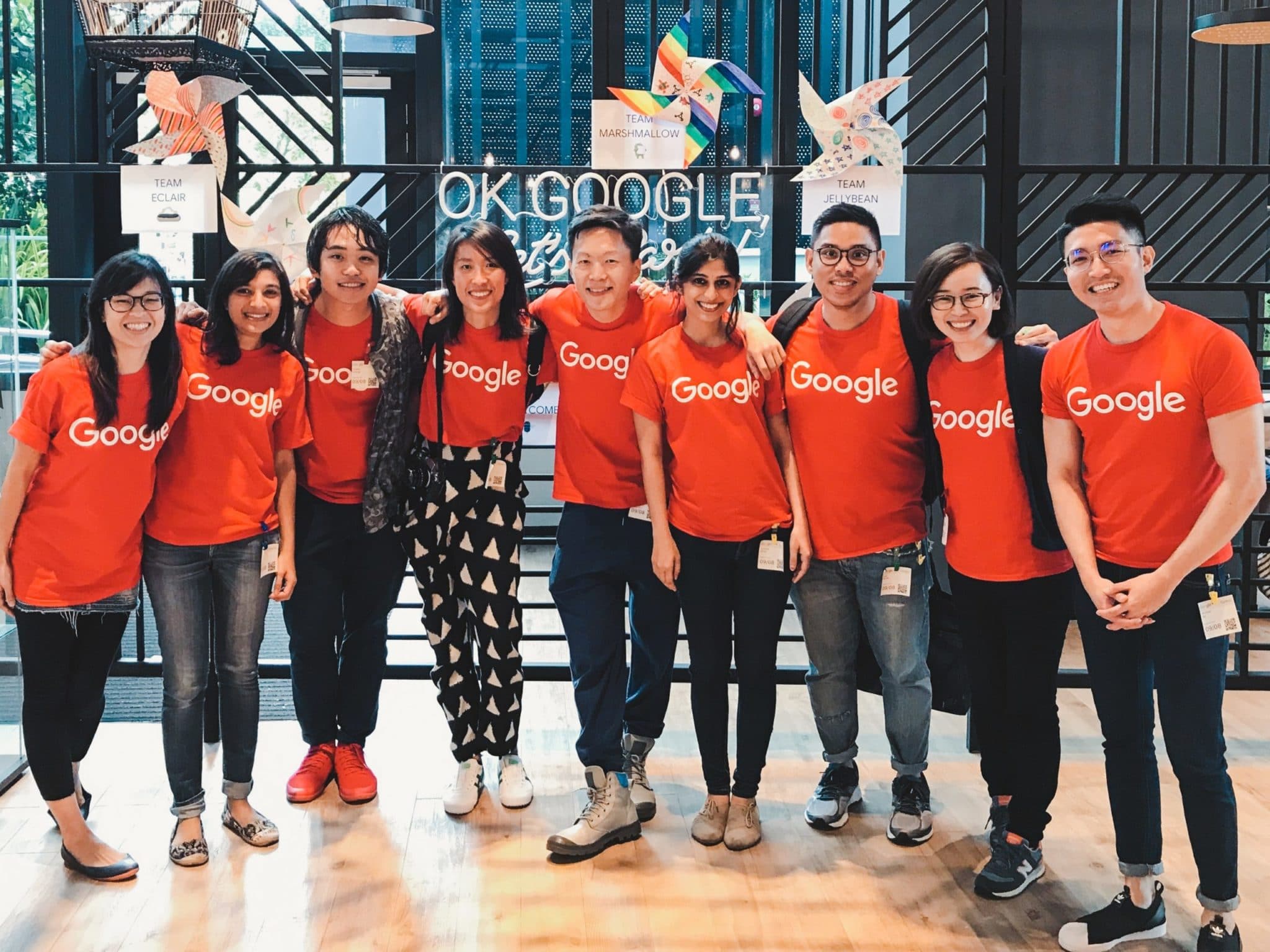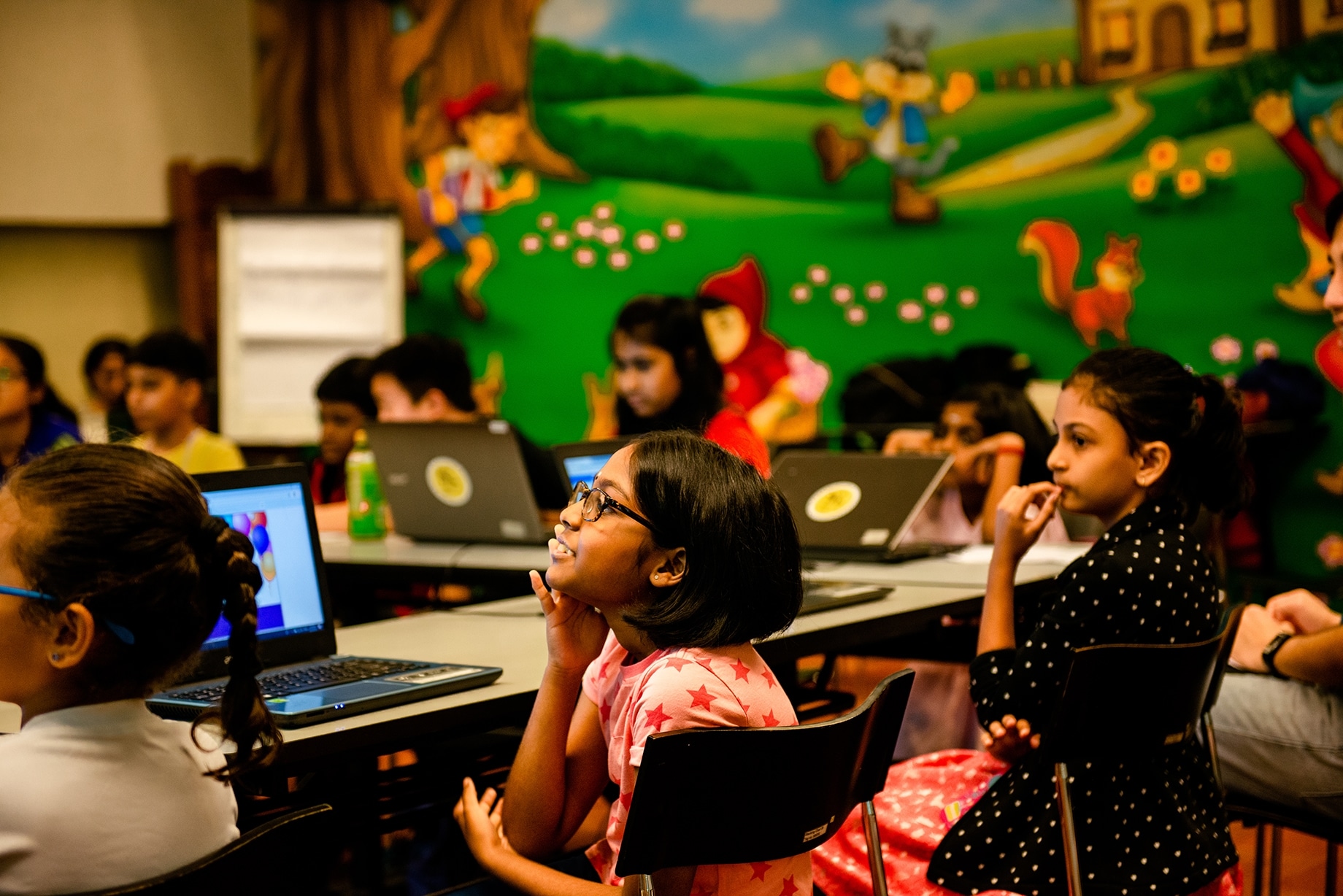Meet Shreya & Michael, the social impact squad behind Code in the Community
July 11, 2019

2 years ago, we were approached by our non-profit partner 21C Girls to run a programme to bridge the digital literacy gap for Singaporean kids from lower-income families and unlock their natural learning abilities – naturally, we were psyched to make an impact for kids with less opportunities, and with the support of Google, we embarked on this adventure and haven’t looked back since!
Today, Code in the Community has impacted 2000 kids in Singapore and counting through free coding classes – getting them excited about the potential of tech via Saturday Kids’ Scratch and Python curriculum and more importantly, inspiring them to learn how to learn. It takes a village to make a real impact, and driving this – alongside our tribe of volunteers, sponsors, and partners – is a small team at Saturday Kids. Behind each class and kids’ happy faces lies months of planning, strategising, and a mountain of hard but necessary work. Get to know Shreya & Michael from the social impact squad who share their stories, take us behind the scenes, and help us understand how and why programmes like Code in the Community make a difference.
What’s your story and how did you get involved with Code in the Community?

Shreya, Michael & some of the other members of the Saturday Kids team at the Code in the Community graduation ceremony at Google
Shreya:
“I learned about Code in the Community after joining Saturday Kids and found it really interesting, so I asked if I could come on board.
It’s been good – of course it’s stressful – you need to make the numbers, and programme management is no joke.
But on a high level it’s satisfying – on Week 1 and Week 10 you see the kids all excited and their parents are so proud of them, and throughout the 10 weeks you see all the stories that come out of the programme. It’s very meaningful and I’m quite happy I got on board.”
Michael:
“When I was young, I was from an underprivileged family and was on the Financial Assistance Scheme (FAS), so I’m happy that I now get to help other FAS kids. I don’t think we had many chances like this in the past.
It is stressful – the higher the student numbers, the more volunteers I need. It’s hard because people are forking out their time for free, but in a sense I also realised there are so many people passionate about helping the less fortunate… it’s heartwarming to see that.”
- Ken & Srinath, just 2 of the volunteers who inspire us!
What goes into running a programme on such a large scale?
Shreya:
“On a regular day, I check student registrations, make sure kids are means-tested, tweak collaterals and our website, reach out to partners and organisations to get them on board. Closer to the run, we’re lugging Chromebooks everywhere, syncing them to wifi, buying what seems to be like a hundred extension cords, packing welcome packs and stuff for the kids to take home.
From a big picture perspective, it doesn’t look like a lot. But the amount of time and the attention to detail it takes for the programme to run smoothly is mind-boggling.
It’s also great to have everyone from Saturday Kids chip in and help when they can. It really takes a village, and CITC is my baby.”
Michael:
“Once locations, venues and sessions are confirmed, I look for volunteers. Our Product team helps to check the coding projects that volunteers submit as part of their application and I assign them to the sessions they want. The tough part is never knowing which locations will be confirmed or cancelled until the last minute – this involves a lot of reshuffling, and making sure everyone knows what they’ve committed for.”
Shreya:
“I’m forever at meetings.”
Michael:
“I’m forever running around.”
What inspires you to do what you do?
Shreya:
“I’m inspired by the parents who write in and are really keen on sending their kids to class; the kids who are willing to travel across the country for our classes; kids who are so inspired after 10 weeks that they want to do more.
And the volunteers who give up their weekends – some volunteer from 11am to 6pm on a Sunday. Some share it with their friends and they come together to volunteer. It’s a nice feeling that people in Singapore are passionate about stuff besides work and making money. You also realise that so many kids out there qualify for the programme and really appreciate the opportunity to be a part of it, and that makes you aware of the privileges you had or didn’t have growing up.”
Michael:
“We see increasing returning volunteers – they’re not doing it to count towards their school’s Community Involvement Programme (CIP), or for the small stipend, or for it to look good on their cert.
For example, we have a 15 year old returning volunteer – Jonathan – who started as an assistant because he wasn’t experienced enough – he told us once that he would one day become a lead instructor, and now he’s a Scratch Instructor leading a large class. At the beginning he told us, “I’m not very good at this right now, but I will be at the end of 10 weeks.”
There are many others with busy regular jobs and families, and they still wake up so early on the weekends – who does that?!
We have some very passionate volunteers teaching at Code in the Community – seeing how kids respond in class is a testament to how good an instructor is.
My high point is the graduation ceremony – you see a lot of happy faces. I’m happy because the kids are happy and the volunteers are happy. That’s the most important thing at the end of the day.”
- Kids & volunteers celebrating their accomplishments at Google.
Why should someone volunteer for Code in the Community?
Shreya:
“You get to give back to the community and help a generation grow, looking forward. Volunteering for Code in the Community is a way of using your privilege or opportunity to help another kid go forward.”
Michael:
“Volunteering comes in a lot of ways – you can clean a beach, help elderly folks in a care centre.
To me, children are the world’s best resource, they are the ones that drive the future. If you can empower those who don’t have financial capability and get them on the same playing field as the rest of those who have the privilege of owning computers and iPads, it just makes the world a better place. We might never defeat the poverty cycle, but we can try our best to make it smaller.”
Shreya:
“At the end of the day, you’re empowering a kid and giving them the opportunity that might lead to a better life. I don’t know how many of these kids will go on to become programmers, but if they enjoyed those 10 weeks of coding and it’s left a positive impression in their mind…I hope they remember what it feels like to learn how to code, and they remember that feeling of achieving something.
I hope that when they grow up and face challenges, they’ll always remember this program and the accompanying feeling of accomplishment, and I hope that motivates and inspires them.”

A snapshot from Scratch class at Geylang East library.
Why should kids take part in Code in the Community?
Shreya:
“Think of CITC as a launchpad for kids’ digital learning. It’s a small class, they learn and benefit from more interaction with instructors; meet kids from different backgrounds kids who may be from similar backgrounds.
Moreover, it’s absolutely free of charge; our volunteers and classes are pretty fun; and it’s about letting your kid experience what coding is like, experience making a project for themselves, and feeling a sense of accomplishment at the end of the day.”
Michael:
“The trend now is programming, machine learning, artificial intelligence – it’s important for kids to start now that it’s free, otherwise how will they catch up further down the road when everyone else has already moved on? This is the easiest way to get equipped with the skills they might need in the future.”
. . .
Code in the Community is a Google-sponsored program which aims to get Singaporean kids from lower-income families excited about technology’s potential and unlock their natural learning abilities. Interested in being a part of something bigger? Register as a student or volunteer instructor here!
This interview is a part of our #codeinthecommunity series of articles exploring what it means and takes to create access to computer science and computational thinking for communities that might not typically have these opportunities.
Check out the other stories in the series:
When we teach kids how to code, what do they learn, really?
Meet (some of) our Superstar Volunteer Instructors



